Shop
Chinoiserie Meridian Tapping Stick for ‘Pai Ba Xu’ in TCM
$7.00 – $28.00
Shipping calculated at checkout.
Enhance your overall well-being with the Chinoiserie Paibaxu Tapping Massage Stick, designed to soothe your neck, bakc, shoulder, tendons and back. This innovative tool complements your active lifestyle, promoting health and recovery after those intense games, perfect for those sedentary office worker. Embrace the harmony of sport and wellness with this remarkable combination, and let your passion for healthy lifestyle.
1 PEOPLE ARE VIEWING THIS RIGHT NOW
ONLY 15 ITEMS LEFT IN STOCK!
DIMENSIONS (IN CENTIMETERS)
H 46 x W 7 x D 3
WEIGHT:
0.2 kg
SKU: 100
Description
Auspicious Cranes
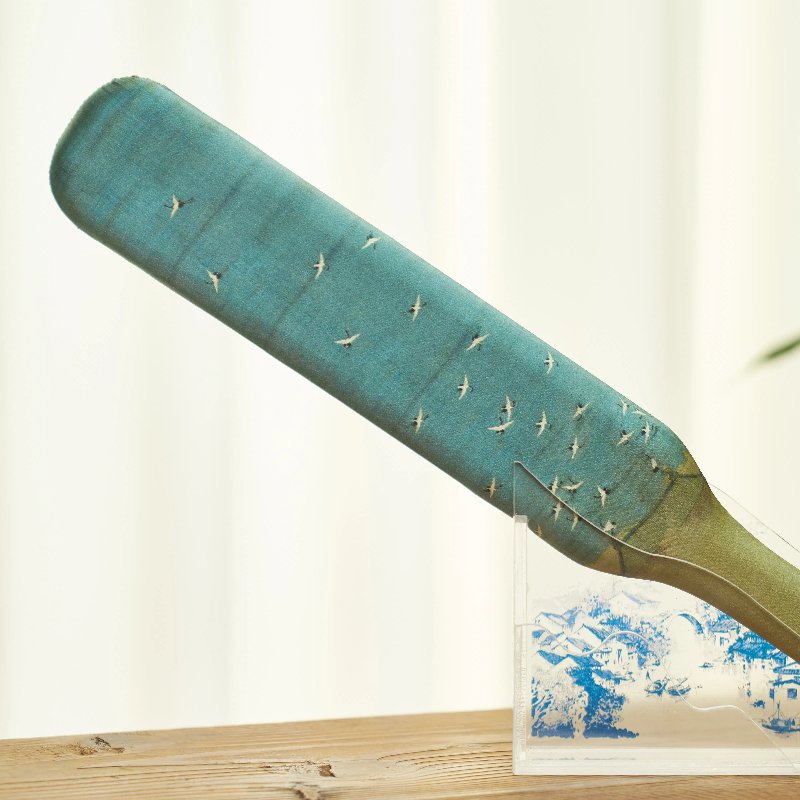
The design of this meridian tapping stick is inspired by Emperor Huizong of Song’s “Auspicious Cranes” painting, with the image on the front and the accompanying poetry on the back. It embodies not only the divine radiance and the nobility of a monarch but also a sense of ethereal and elegant movement. The crane, symbolizing lofty aspirations and noble character, is depicted with two cranes perched on the rooftop, graceful and serene, conveying motion through stillness, echoing the cranes circling in the sky, adding a touch of charm and poise to the piece.
Green Mountains and Clear Waters
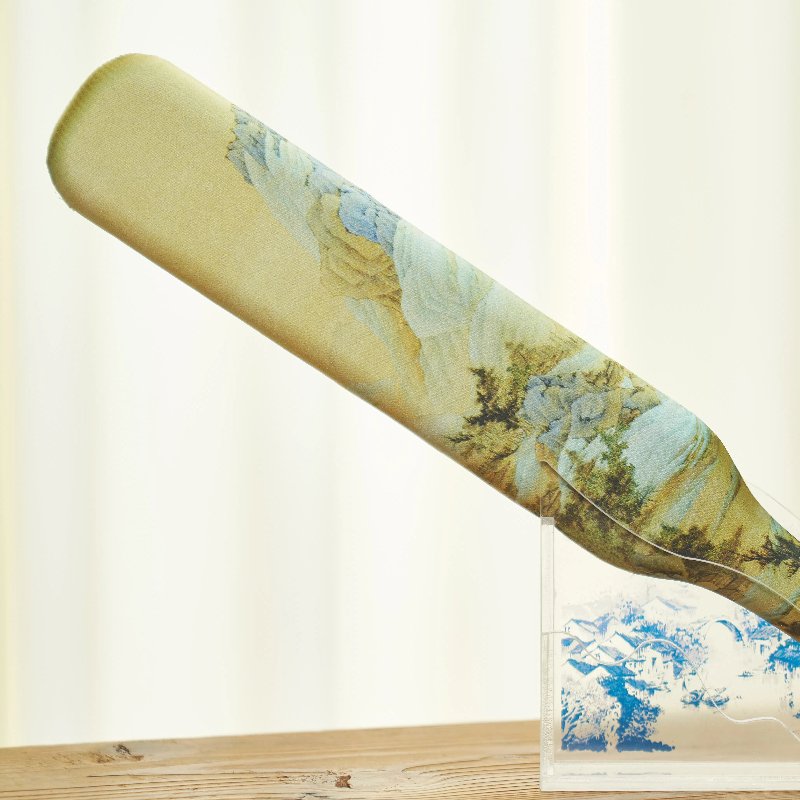
The design of this meridian tapping stick is inspired by the “A Thousand Li of Rivers and Mountains” painting. This painting expresses the ideal living environment for humans, a coexistence of heaven and humanity as one, which has long been rooted in the hearts of the Chinese people and in the depths of their cultural heritage. It is presented through the form of landscape painting and also determines the direction in which people choose their living environments. The ancients have long provided the answer of “unity of heaven and man” and the harmonious relationship between humans and nature as “the way follows nature,” a philosophy that pursues beautiful and pleasing natural and man-made environments, which is always included in the ideology of landscape painting.
Longevity and Health
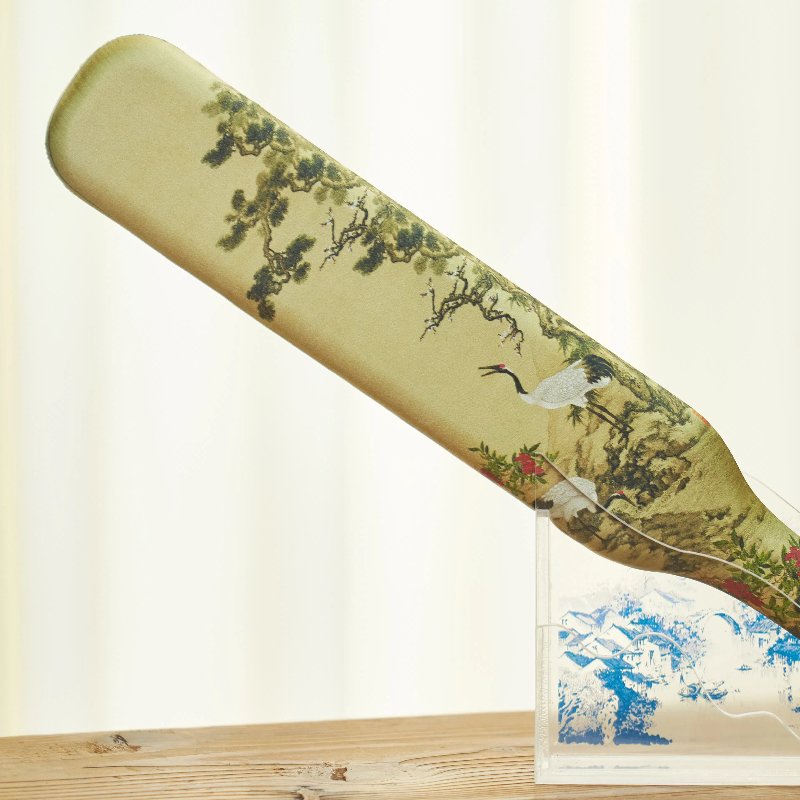 The design of this meridian tapping stick is inspired by the “Pine and Plum Cranes” painting. The “Pine and Plum Cranes” painting depicts the robust and elegant form of ancient pines, the twisting and coiling of old plum trees, and the scenes of cranes either stretching their necks to the sky or bending down to forage, symbolizing the auspicious meanings of “continuous fortune and longevity, and a pure and refined spirit.” When this painting was completed, Shen Quan was “seventy-eight years old,” and it is quite rare for someone of such an advanced age to create such meticulous paintings, depicting the double cranes with both form and spirit, and an extraordinary demeanor. Shen Quan’s painting skills were superb; he had crossed over to Japan to teach his art, profoundly influencing the Nagasaki school of painting in the Edo period of Japan, thereby earning the reputation of “the foremost of the imported painters,” and making significant contributions to Sino-Japanese cultural exchanges.
The design of this meridian tapping stick is inspired by the “Pine and Plum Cranes” painting. The “Pine and Plum Cranes” painting depicts the robust and elegant form of ancient pines, the twisting and coiling of old plum trees, and the scenes of cranes either stretching their necks to the sky or bending down to forage, symbolizing the auspicious meanings of “continuous fortune and longevity, and a pure and refined spirit.” When this painting was completed, Shen Quan was “seventy-eight years old,” and it is quite rare for someone of such an advanced age to create such meticulous paintings, depicting the double cranes with both form and spirit, and an extraordinary demeanor. Shen Quan’s painting skills were superb; he had crossed over to Japan to teach his art, profoundly influencing the Nagasaki school of painting in the Edo period of Japan, thereby earning the reputation of “the foremost of the imported painters,” and making significant contributions to Sino-Japanese cultural exchanges.
Conjugal Bliss

The design of this meridian tapping stick is inspired by the “Flower and Feather Scroll.” The “Flower and Feather Scroll” depicts the vibrant scene of spring, with apricot blossoms in full bloom and willow trees swaying in the wind, along with mynas and mountain birds resting and flying among the flowers. Schools of fish swim freely in the streams, and on the banks, pairs of mandarin ducks accompany each other, creating a delightful scene filled with the essence of spring. This design aims to express the beautiful situation of lovers supporting each other and living in harmony, like a well-tuned musical ensemble.
Spring River And Autumn Moon

The inspiration for this design is drawn from the Tang Dynasty poet Zhang Ruoxu’s poem “Spring River Flower Moon Night,” which seems to depict the most refreshing moonlit nights of spring in the Jiangnan region. With the moonlit night as the main theme and the river as the backdrop, the poem paints a picture of a serene, distant, and ethereal spring river under the moonlight. Under the moon’s glow, all the scenery becomes exceptionally captivating, and gazing up at the white magnolias in the night sky is particularly heart-stirring.
The designer was moved by the sincere and touching emotions of separation and longing expressed in the poem, where a fisher girl in a pavilion yearns for her absent lover, expressing her love and longing towards the bright moon. A pair of white peacocks symbolize pure love between each other. The lines “Who by the riverbank first saw the moon? When did the river moon first shine on a person?” create a profound, vast, and tranquil realm with an ethereal and enigmatic moonlight, filled with philosophical implications. The moonlit nights of Jiangnan are indeed so profound and serenely beautiful!
Gusu Twelve Ladies

The “Gusu Twelve Ladies” are composed of twelve distinct professions that represent the essence of the Jiangnan water town, each embodying the history of traditional Suzhou trades and evolving into a part of the Wu culture heritage. These professions include the boatwoman, embroiderer, weaver, tea maker, fan maker, lantern maker, zither player, silkworm breeder, flower seller, singer, painter, and pearl diver.
The designer captures the unique charm of Jiangnan in summer through the depiction of a boatwoman gathering lotus flowers, a scene that resonates with the essence of the region. The character is portrayed using the traditional Chinese fine line drawing technique, which emphasizes the softness and grace of the traditional female figure. The main background color scheme is modern, inspired by the macaron color palette, combining classical and contemporary elements to highlight a strong, fashionable feminine aura.
The Peony Pavilion
 The design of this “Peony Pavilion” is inspired by the play of the same name by the Ming Dynasty dramatist Tang Xianzu. The love story between the characters Du Liniang and Liu Mengmei in the play is imbued with a strong sense of idealism. The designer has refined and redesigned the characters from the play, using a cartoonish, Q-version comic style to express the unique charm of Kunqu Opera. The peonies in the picture are delicately rendered, highlighting the design sense of the scarf, making it both spirited and fashionable.
The design of this “Peony Pavilion” is inspired by the play of the same name by the Ming Dynasty dramatist Tang Xianzu. The love story between the characters Du Liniang and Liu Mengmei in the play is imbued with a strong sense of idealism. The designer has refined and redesigned the characters from the play, using a cartoonish, Q-version comic style to express the unique charm of Kunqu Opera. The peonies in the picture are delicately rendered, highlighting the design sense of the scarf, making it both spirited and fashionable.
This design captures the essence of the romantic and idealistic love story from “Peony Pavilion,” translating it into a modern and stylish format that resonates with contemporary audiences. By using a cartoonish approach, the design brings a fresh and lively interpretation to the classic tale, while the meticulous depiction of peonies adds a touch of elegance and tradition, blending the old with the new in a harmonious and fashionable way.
Golden Age Gusu

The design of this piece is inspired by the Qing Dynasty court painter Xu Yang’s creation, “Shengshi Shengzhi Tu” (also known as “Gusu Fanhua Tu”). By combining traditional panoramic composition with modern illustration art, the designer has created a spatial artwork that captures the essence of the Jiangnan water town’s scenery, including the lake views, pastoral villages, flowing waters, ancient ferries, and bustling marketplaces. The design incorporates a dialogue between reality and history, rendered with a unique flavor, using the “旷观” (expansive view) form to depict figures, buildings, and the bustling crowds in an orderly and lively manner. The designer has integrated famous Suzhou landmarks such as Pingjiang Road, Shantang Street, Hanshan Temple, Tiger Hill, Qionglong Mountain, Shihu Lake, and Taihu Lake into a harmonious picture with a rhythmic rhythm, expressing the lively and prosperous atmosphere of present-day Suzhou.
This design not only reflects the historical prosperity depicted in Xu Yang’s “Shengshi Shengzhi Tu” but also brings a modern and fashionable touch to the traditional Jiangnan scenery, making it a unique blend of the past and the present.
Suzhou Pingjiang Road
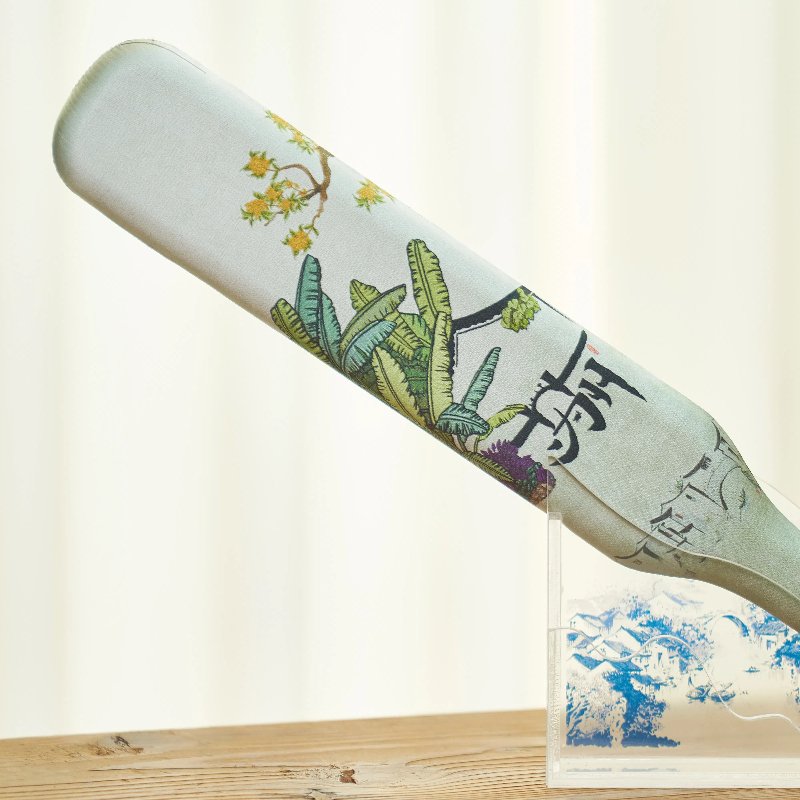 If one were to say that Jiangnan possesses ten parts of beauty, nine parts would be found in the city of Gusu. And if one were to say that the most exquisite spring in Gusu is found nowhere else, half of it is encapsulated in Pingjiang Road. Every city has a street like this, bustling with tourists checking in, filled with popular shops offering delicious food and fun activities, a place to while away idle hours. In Beijing, it’s called Nanluoguxiang, in Chengdu, it’s Kuanzhai Alley, and in Suzhou, it’s called Pingjiang Road.
If one were to say that Jiangnan possesses ten parts of beauty, nine parts would be found in the city of Gusu. And if one were to say that the most exquisite spring in Gusu is found nowhere else, half of it is encapsulated in Pingjiang Road. Every city has a street like this, bustling with tourists checking in, filled with popular shops offering delicious food and fun activities, a place to while away idle hours. In Beijing, it’s called Nanluoguxiang, in Chengdu, it’s Kuanzhai Alley, and in Suzhou, it’s called Pingjiang Road.
“Upon arriving in Gusu, you’ll find that every household is nestled by the river.” Pingjiang Road, with its essence of classical Chinese beauty, embodies the charm of the water towns, perhaps the most quintessential Gusu experience. It could be said that Pingjiang Road is the true representation of the old Gusu with its small bridges and flowing water, the Jiangnan we remember. The spaciousness and elegance, the simplicity and vibrancy of Pingjiang Road, seem to possess a magical power that can instantly soothe and relax the tense mind and body.
Suzhou Wen Wisteria

The Suzhou Museum, designed by the modern architectural master I.M. Pei, features a geometric design that does not lose its classical beauty, exuding an atmosphere of fashion and grandeur. The museum adopts the basic color scheme that has been used in Jiangnan since ancient times, with white walls and gray tiles. Located in the corner of the Zhongwang Mansion within the Suzhou Museum, there is a Wisteria plant that has been nearly 500 years old, planted by Wen Zhengming, also known as the “Wen Wisteria.”
In the most beautiful month of April, the Wisteria at the Suzhou Museum cascades like a purple waterfall, becoming a gentle highlight among the pink walls and black tiles. The blooming of the “Wen Wisteria” fully displays the beauty of the East.
A Flourishing Deer Among Flowers
 The design inspiration for “A Deer Amidst Blooms” comes from the Nine-Colored Deer, one of the four auspicious creatures in the Dunhuang murals, combined with the carefree spirit of Su Shi’s verse “With a bamboo staff and straw sandals, lighter than a horse, I face the misty rain with a straw cape, throughout my life.” May all modern women be greeted by the slanting sun on the mountain tops, with a path adorned with flowers and a leisurely stroll. “A Deer Amidst Blooms” embodies the freedom and grace of “going forward in plain shoes, willingly alone.” The deep courtyards and high pavilions of ancient times can no longer confine the brave and fearless spirit of women in modern times. Striding forward with spontaneity, self-motivation, self-appreciation, and self-praise— we light our lamps to illuminate the way, and our hair is adorned with blossoms.
The design inspiration for “A Deer Amidst Blooms” comes from the Nine-Colored Deer, one of the four auspicious creatures in the Dunhuang murals, combined with the carefree spirit of Su Shi’s verse “With a bamboo staff and straw sandals, lighter than a horse, I face the misty rain with a straw cape, throughout my life.” May all modern women be greeted by the slanting sun on the mountain tops, with a path adorned with flowers and a leisurely stroll. “A Deer Amidst Blooms” embodies the freedom and grace of “going forward in plain shoes, willingly alone.” The deep courtyards and high pavilions of ancient times can no longer confine the brave and fearless spirit of women in modern times. Striding forward with spontaneity, self-motivation, self-appreciation, and self-praise— we light our lamps to illuminate the way, and our hair is adorned with blossoms.
Impressions of Suzhou
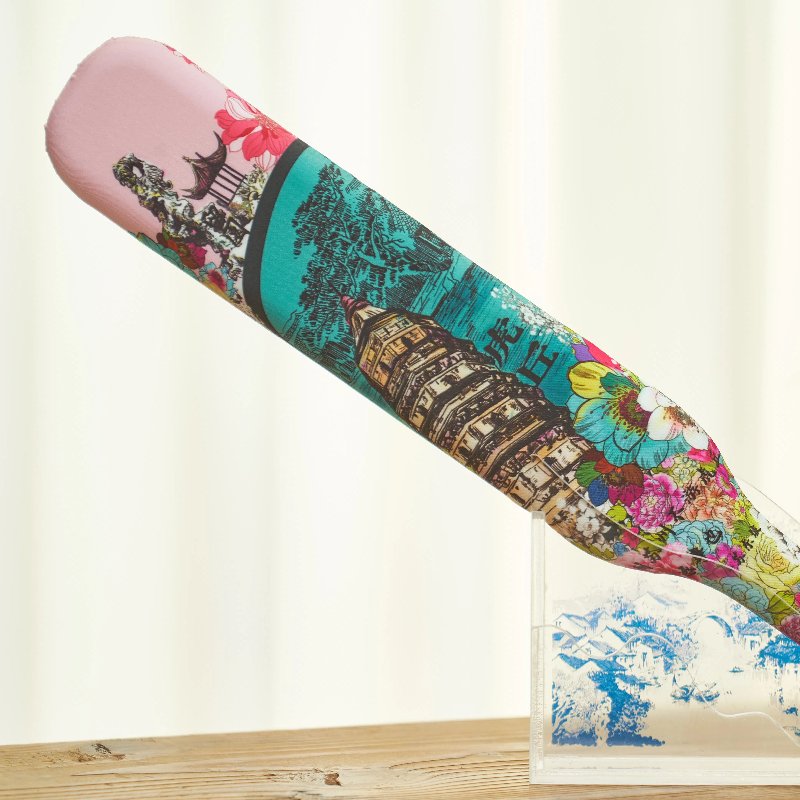
The designer has integrated their own observations and feelings from living in Suzhou for many years into this artwork. By using reflections from both water and land, they have naturally incorporated the humanistic and natural aspects, as well as ancient and modern architecture of Gusu City into the piece. Elements of Gusu such as the Tiger Hill Pagoda, Guanyun Peak, pavilions, towers, and Pingjiang Road are scattered throughout the composition, offering a rich tapestry that is worth savoring and appreciating at leisure.
Say Goodbye to Aches and Fatigue
Introducing the Acupressure Massager – your personal wellness assistant designed to target those hard-to-reach spots and revitalize your body. Whether you’re a student or an office warrior, this device is here to ease muscle tension and reduce stress.
What is the Acupressure Massager?
Our acupressure massager is a self-help body tapping device that uses the ancient art of meridian tapping to stimulate acupressure points on your body. It’s the perfect tool for anyone looking to improve overall well-being.
How Does it Work?
Simply place the massager on the desired area and let the rhythmic tapping mimic traditional Chinese medicine techniques. The massager addresses common areas of discomfort like shoulders, back, and neck, promotes blood circulation, and reduces muscle stiffness.
Key Benefits
Some key benefits include:
- Targeted relief: Directly addresses areas of discomfort.
- Muscle relaxation: Promotes blood circulation and reduces stiffness.
- Stress relief: Helps to calm the mind and body.
- Natural approach: A drug-free, non-invasive method.
About This Item
| Weight | 0.2 kg |
|---|---|
| Dimensions | 46 × 7 × 3 cm |
| Brand | Ecobamtech |
| Materials | Polyester, Mulberry Silk |
| Patterns | Suzhou Wen Wisteria, Auspicious Cranes, Longevity and Health, A Flourishing Deer Among Flowers, Suzhou Pingjiang Road, Conjugal Bliss, Gusu Twelve Ladies, Impressions of Suzhou, Golden Age Gusu, The Peony Pavilion, Spring River and Autumn Moon, Green Mountains and Clear Waters |
Customer Review
There are no reviews yet.











































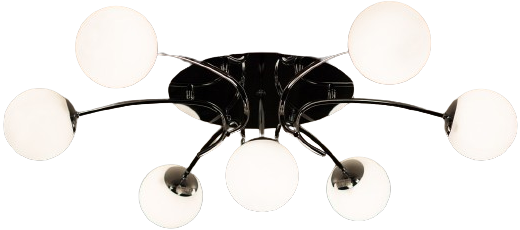

Your email address will not be published.